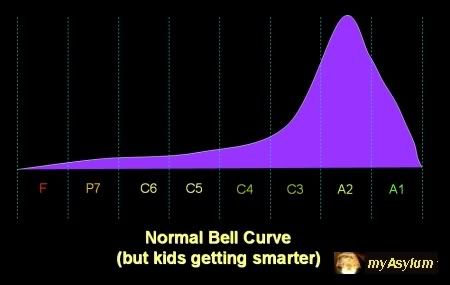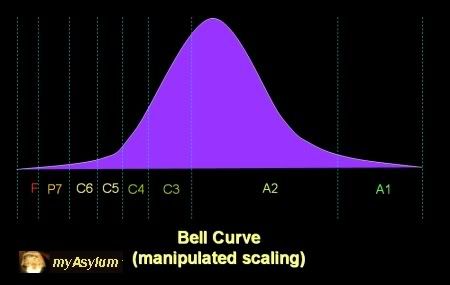Curving out the A's
Technorati tags: Commentary, Obsession, SPM, Education, Malaysia
It's that time of year again when we pander to our collective societal obsession of counting how many A1's one can possibly get in the Sijil Pelajaran Malaysia (SPM). What was it this year? 4,311 straight-A students (via The Star)? Out of a total of 416,717 students who sat for the exam last year, that's about 1.03% (give or take). Simply fanstastic!
Or is it?
 Add another few thousand bricks to the wall
Add another few thousand bricks to the wall
(image from the film "Pink Floyd The Wall", taken from here)
Does scoring straight A's necessarily translate to intelligence, or just hard work and rote learning? And if it's the latter, are we teaching our school kids to think as well, or just follow instructions - and previous years' sample questions?
Hard work, of course, is important. No doubt about that. Rote-learning, however, probably won't get you very far in life. Real life is a lot more dynamic than the predictive cycle of popular exam questions, that has spawned an entire cottage indusry of tuition centers.
No sour grapes here, though. Walski did pretty good in his SPM way back in the early 80's. But it does make one wonder if the bar is as high as it used to be or not. Back then, however, one would typically take up to 12 subjects (Walski took 10). These days we're talking about 18 or 19 subjects. Un-freakin'-believable.
And then you get the WTF?!? kinda stories, like this one (via The Star), where a father and his son claim to have gotten 24 A1's each in the recent SPM. Turns out, they falsified the result slips - for what reason, one can only guess (the news report mentioned publicity).
The more A's the better, apparently.
Which brings up another question: is churning out as many A's as humanly possible (or some might argue, inhumanly) a reasonable measure of the quality of Malaysian education? Or is it merely a feel-good indicator that means squat in the real-world sense, except to the politicians responsible for the Education System?
(how to curve-up more A's, in the full post)
Typically, exam grade distributions are derived using a Normal Distribution curve, or the Bell Curve, as it is commonly known.
 Arbitrary equal distribution of a normal Bell Curve
Arbitrary equal distribution of a normal Bell Curve
Now, one would, of course, love to imagine that our kids are actually getting smarter year on year. In which case, the curve might look something like this.
 Bell Curve of kids getting smarter
Bell Curve of kids getting smarter
Alternatively, if it was a high number of A's, you could shift the scale to artificially create more A's, if that's what you really wanted to.
 Rescaling the Bell Curve to generate the A's
Rescaling the Bell Curve to generate the A's
So, which is it? Guess that's an Official Secret we'll never know...
Now, Walski is not insinuating that the curves have been manipulated, simply that the possibility exists. And also to show that the mere number of A1's and A2's isn't a measure of anything significant. Creative statistics can do wonders, you know?
Nevertheless, Walski wishes to congratulate those who got the A's by the bucket-fulls. And to those that didn't fare so well, don't be disheartened. SPM is not the end of one's learning experience in this life. It's just the beginning. And it definitely isn't something worth hurting yourself over.
Lastly, to parents and students alike: real learning never ends, and real education doesn't stop with academia alone. Keep this attitude and in the long run, the number of A's you managed to score in the SPM, or didn't manage to, won't make one iota of difference.
It's your attitude towards life that matters most - and that's the bigger picture no Bell Curve can manufacture.
















